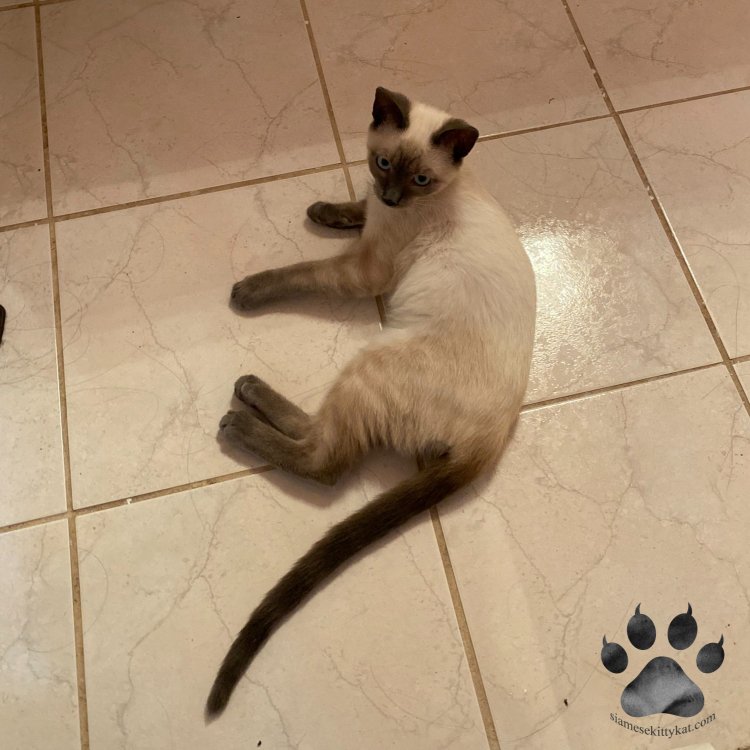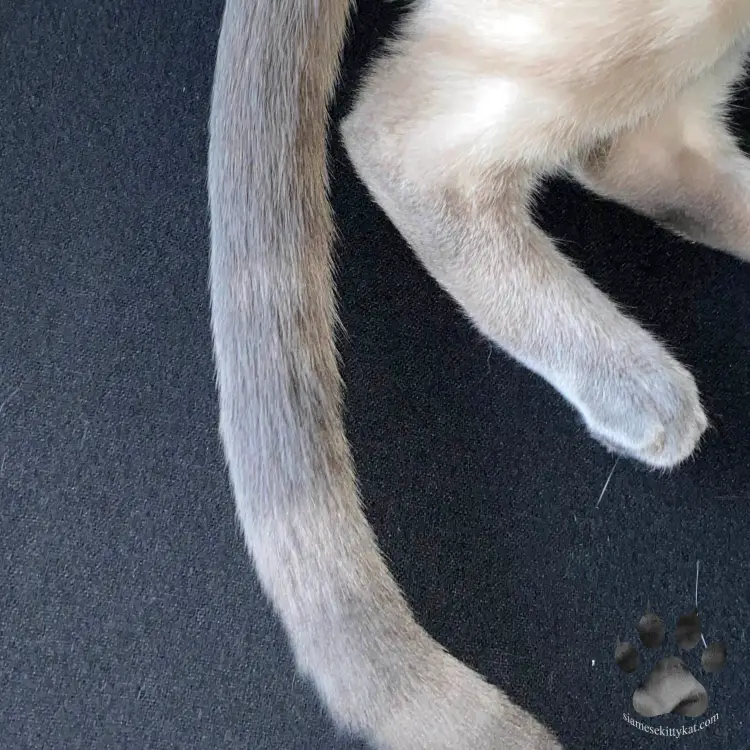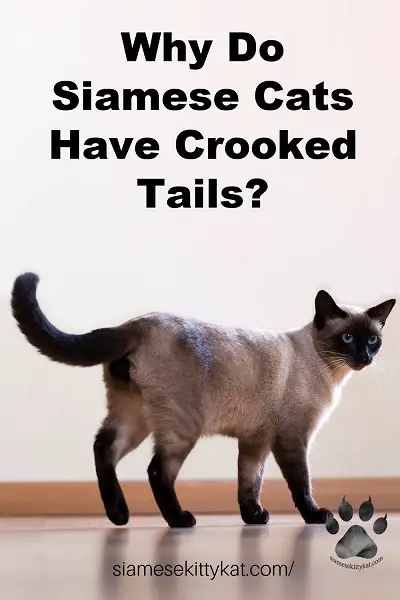This is why Siamese cats have crooked tails: Once upon a time, in a kingdom far away in Siam, the Queen asked a group of Siamese cats to watch over a golden royal goblet. In feline fashion, they wrapped their tails around the goblet for extra security.
Or at least Siamese cats used to have crooked tails. Considered undesirable by uptight cat fanciers, breeders have worked to eliminate this trait. The crossed eyes so emblematic of the breed have also suffered the same fate.
Another legend shares that Siamese princesses stored their rings on their cats’ tails, creating the twist. They did this while bathing and doing other everyday tasks.
There is another more scientific theory, that claims that inbreeding caused the curve. This is a recessive trait that spreads in urban environments like cities. Because street cats don’t tend to roam far, they would mate with their relatives. Hence the crooked tail.
It’s an interesting idea, though I couldn’t find any definitive proof. Whatever the reason, this is just one more thing that makes my Siamese cats unique!
What does it mean if my cat’s tail is bent?
You may have noticed your cat bending her tail like a question mark. This indicates excitement and curiosity. And because she’s a cat, curiosity happens a lot!
A curled tail also signals a kind of energy – the supernatural energy only felines possess! So you might want to tear your eyes away from this screen and play a game of chase with him. Or watch him for a while. It’ll be as energizing as a shot of java. If you want to help bring out that high energy, you can also get them a moving toy like this OurPets Play-N-Squeak Mouse Hunter Cat Toy from Amazon.
It also actually does have something to do with the urban legend mentioned above. Cats wrap their tails around themselves when they’re comfy, cozy, and content.
You may have also seen your cat react to a tense situation. He’ll stand still as a statue with his tail wrapped around his body. Confused yet? Of course, because this is your cat’s mission in life.
But to ease up your confusion a little, here’s a brief guide of what each form of a Siamese cat’s tail mean:
| Afraid |  |
| Happy |  |
| Irritated |  |
| Friendly |  |
| Interested |  |
| Crazy |  |
| Amorous mood |  |
| Concerned |  |
| Angry |  |
What breed of cat has a kinked tail?

Your cat’s heritage is very wrapped up in her tail. If she has a curved or stumped one, it’s a safe bet that she might be Asian.
Descended from small jungle cats, the Indonesian cat is a first cousin of the Siamese. But she most likely doesn’t know that, resulting in her crooked or stumpy tail.
The cats of Jakarta and Yogyakarta want you to think they won their stubby tails in a street fight. But it actually has more to do with the same interbred recessive gene.
You can also find stubby tails in Malaysia and other neighboring countries. Sometimes, these cats have no tail at all! Which is a problem, because cats need their tails for many reasons.
Burma (Myanmar), shares a lot with Indonesia, its closest cousin to the south – including its cats. Felines from both areas are lean, muscular city scrappers. And they both have kinked tails.
As with the Siamese, these cats have maintained their tails in the east. In North America, breeders tend to engineer these traits out. This is too bad because kinked tails are cool!
Why do Siamese cats have tails?

Ever wonder why it’s called the “catwalk”? Catwalk is another name for a fashion show runway, which is always narrow. Catwalk also refers to a narrow pathway in a construction installation.
Cats are famous for their ability to walk in a very narrow, straight line. His tail allows him to do this with perfect balance. The tip of the tail allows him to judge the distance between spaces. Models don’t have tails, of course, so is this the cause of their many stumbles?
What’s in a tail? A lot of personality! A cat’s tail can tell you a lot about their emotions. But it also allows her to communicate them, quite clearly in fact! The twitch of a tail indicates irritation or intrigue. A straight tail high up in the air means she is happy to see you.
Your cat also uses his tail for feline-to-feline communication. Cats communicate with their tails the way we do with our facial expressions. A tail swishing back and forth signifies irritation. If his tail puffs up, you can bet there is another cat, or predator, nearby. And if he swishes a puffy tail back and forth, get ready to take out the water bottle because you’ll soon need it!
How can I tell if my cat is mixed with Siamese?
This was another result of the royal golden goblet mission. The poor guys focused on the goblet so hard, their eyes crossed with the effort, and stayed that way!
Siamese cats have the unique characteristic of a mood ring. Though fortune tellers will tell you otherwise, mood rings change with the temperature. And so do the coats of Siamese cats.
In our Genetics 101 class, you learned that a gene for albinism determines their light body color. What I haven’t yet told you is that this gene is only active above a certain temperature.
In Thailand, the temperature hardly ever drops below 15 degrees celsius. (They speak in celsius in Thailand). So if my Batman and Robyn remain in Florida, they’ll stay a light shade of white. But if I transported them to the cooler climes of, say, New York, their pigment would turn back on.
The scientific mechanism behind this pigment gene is likely responsible for their markings. The darker points are always on the outermost cooler parts of the body – the tail, legs, and ears.
This is also the reason why Siamese kittens are born almost completely white. The warmth of the mother’s womb prevents the pigment from appearing. Then, once exposed to the outside air, color begins to appear. Like watercolors!
Could this also be why Siamese cats like to be up high?
It takes a lot of pigment to pull off those sparkling blue eyes. But as with everything in life, there are tradeoffs. This same pigment limits their ability to see in the dark.
They are also missing a key layer of tissue in the eye called the tapetum lucidum. Lying right below the retina, it is a retroreflector that increases the light pouring in.
You should also know that cats are very protective of their tails. Especially the tip, which she uses for balance. The nerves in the tail are very sensitive and injuries can cause permanent damage. As discussed above, cats can live without their tails – but we doubt they’d want to.
Thus ends the tale of the tail. Check back soon to find out if you should feed your Siamese cat milk.
Want to immerse yourself more in the captivating world of Siamese cats? I’ve got all the information you need from their distinct color points to their fun personalities: Siamese Cats: Unique Features and Personality
Get your FREE Siamese Cat 2024 Printable Calendar


